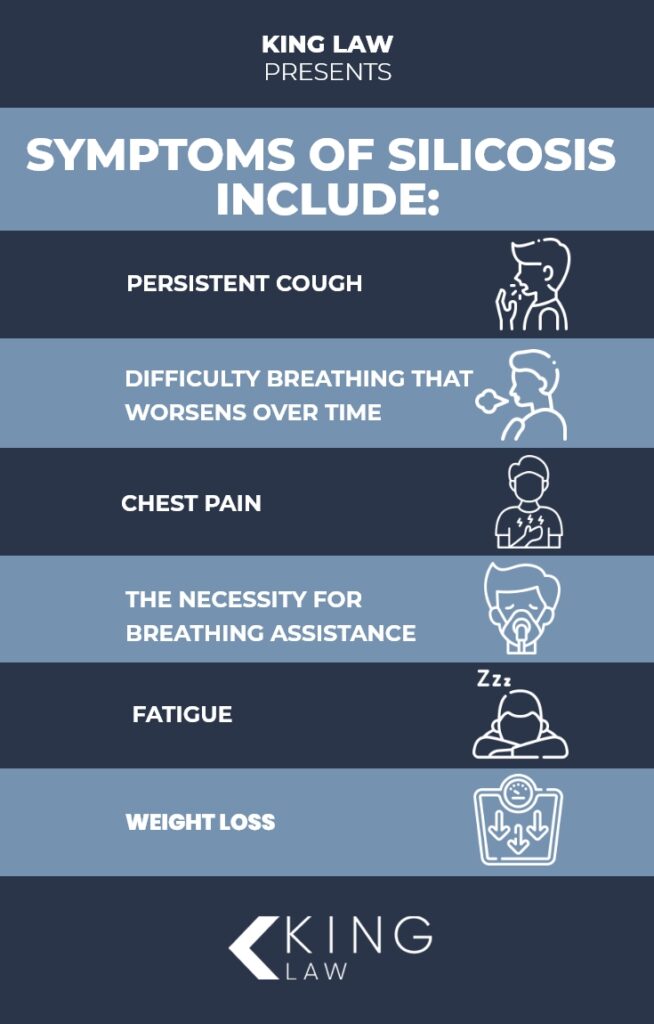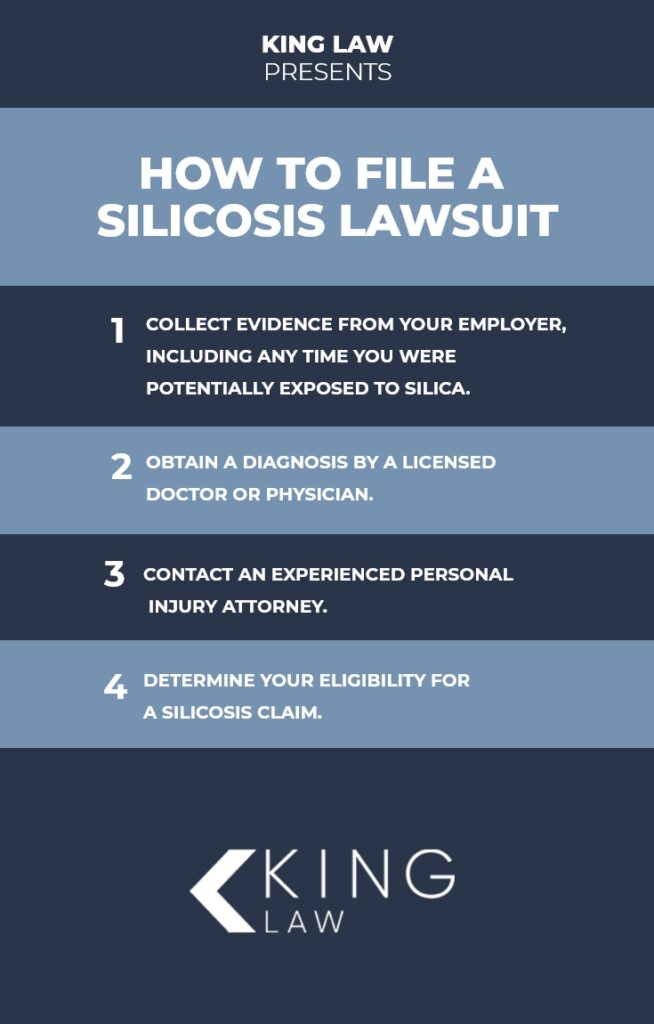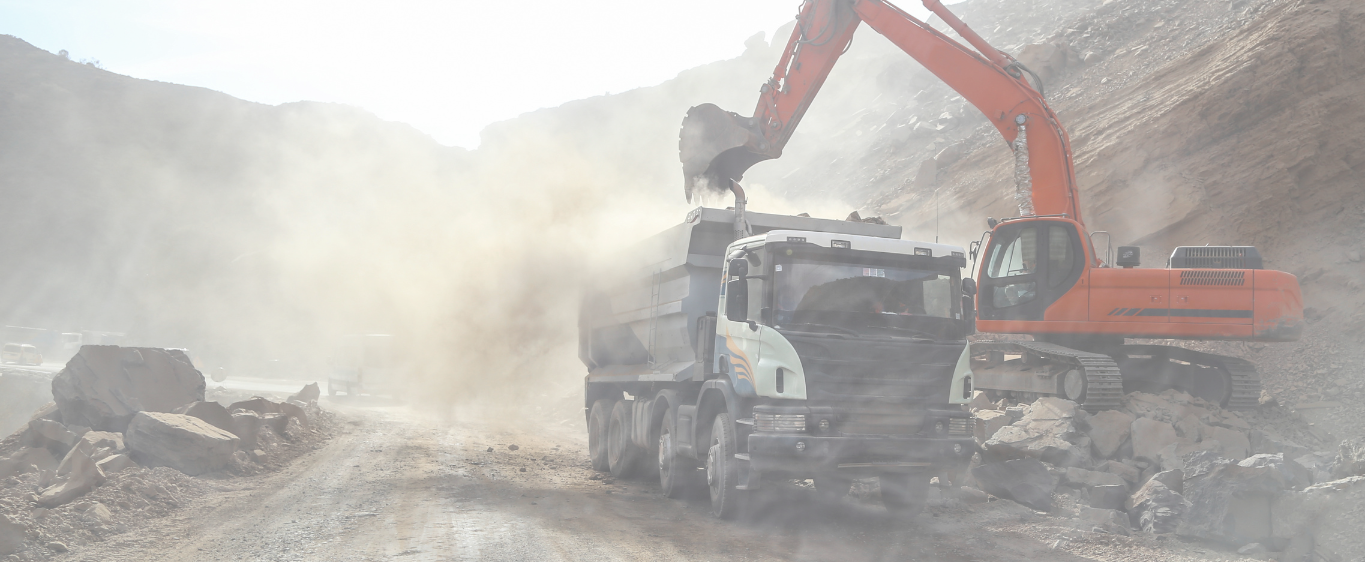About the Silicosis Lawsuit
The American Lung Association estimates that over 2 million workers in the United States are at risk for silica exposure. Construction workers and individuals working in stone fabrication are potentially exposed to the dangerous and deadly substance every day. Exposure can cause a serious, incurable lung disease known as silicosis.
Individuals who have been exposed to silica may be entitled to file a silicosis lawsuit. At King Law, we are currently accepting cases for potential silicosis lung cancer lawsuits. We have decades of experience helping workers nationwide that have been injured as a result of employers failing to take the proper safety standards and preventative measures to keep them safe.
If you have been diagnosed with silicosis, contact our office to schedule a free, no-obligation consultation.
Silicosis Class Action Lawsuit Update – 2024 Updates
September 2023: Attorneys are currently investigating cases related to silica exposure. Silica is a substance commonly found in engineered stone, primarily composed of quartz. Exposure to silica can cause a deadly lung disease known as silicosis.
A rise in silicosis cases among construction workers and individuals working in stone fabrication has many questioning whether employers have done enough to protect employees from this dangerous substance.
With millions of people exposed, it is expected that silicosis lawsuits will increase over the next few years and potentially lead to a silicosis class action lawsuit.
On this page:
Signs and Symptoms of Silicosis
How Much Silica Dust Causes Silicosis?
Silicosis Diagnosis: The Complexities of a Diagnosis
How to Prevent Silicosis Exposure
How to File a Silicosis Lawsuit
Silicosis Lawsuit Settlement Amounts
What Is Silicosis?
Silicosis is a deadly lung disorder. It is caused by the inhalation of silica. Silica are tiny crystalline particles of silicon dioxide that are found in materials like sand and rock. The most common form of silica is quartz. Breathing in silica dust can result in irreversible, fatal respiratory diseases.
Silicosis is believed to have been around since at least the 1700s, known by different names. However, an increase in the manufacturing of fabricated stone such as quartz countertops is believed to have caused a spike in the occurrence of the lung disease. Hundreds of deaths are reported each year related to silicosis. It is a progressive disease that can take decades to develop after first exposure.
The Occupational Safety and Health Administration (OSHA) has issued crystalline silica standards for industries to limit workers’ exposure to silica dust. When employers fail to comply with these regulations and safety standards, they may be held accountable for resulting injuries. Workers at the highest risk of silicosis include individuals in the construction industry, masonry, glass manufacturing, and coal mining.
What Causes Silicosis?
Silicosis is caused by the inhalation of silica dust. Silica are tiny particles that are found in materials like granite and quartz. When products, like countertops and engineered stone, are cut or sanded, tiny bits of silica dust are released into the air. Workers then inhale the particles, resulting in damage to their lung air sacs and leading to scarring.
Inhalation of silica can lead to:
- Lung tissue inflammation
- Scar tissue formation
- Breathing difficulties
- Decreased lung capacity
- Crackling sounds when breathing
- Increased risks of tuberculosis and lung cancer
- Progressive Massive Fibrosis (PMF)
- Chronic bronchitis
The U.S. Centers for Disease Control and Prevention (CDC) notes that quartz surface imports to the country increased 800% from 2010 -2018, aligning with a sharp rise in silicosis rates. Engineered stone materials such as quartz contain substantially more respirable crystalline silica (RCS) compared to natural stone. It is estimated that engineered stone contains over 90% silica, while granite has around 45%.
In workplaces where stone countertops are made, particles released during sanding or manufacturing are often finer than a grain of sand. Any worker engaged in the cutting, grinding, drilling, or polishing of these materials is at risk of exposure. Employers must do more to protect their employees, such as implementing wet processing, having proper ventilation, and providing respirators.
Signs and Symptoms of Silicosis
Because silicosis is a progressive disease that may not manifest for 10 to 30 years after the first exposure to silica, it can be challenging to timely diagnose and treat. Signs of silicosis are frequently ignored until the disease has advanced into late stages. Silicosis is incurable and can prove deadly.
Symptoms of silicosis include:
- Persistent cough
- Difficulty breathing that worsens over time
- Chest pain
- The necessity for breathing assistance
- Fatigue
- Weight loss
Untreated silicosis symptoms can lead to tuberculosis, bronchitis, lung cancer, and kidney disease. It is imperative not to ignore the early symptoms of silicosis, as they may become life-threatening over time.
The American Lung Association estimates that 2.3 million U.S. workers are exposed to silica in their workplaces. Despite the known risks regarding silica inhalation, many employers continue to fail to adhere to safety standards set forth by OSHA and other regulatory agencies. Individuals diagnosed with silicosis are strongly encouraged to consider legal action.
Types of Silicosis
There are three basic types of silicosis: simple or chronic silicosis, accelerated silicosis, and acute silicosis. All types of silicosis are dangerous because the effects of silica dust inhalation are irreversible. In severe cases, silicosis may require a lung transplant.
The 3 types of silicosis are:
- Simple/chronic silicosis – Simple or chronic silicosis generally develops 10 to 30 years after exposure. It frequently affects the upper lungs and may cause scarring. Chronic silicosis symptoms include breathlessness, potentially resembling Chronic Obstructive Pulmonary Disease (COPD). It can also be difficult to distinguish it from chronic bronchitis or emphysema.
- Accelerated silicosis – Accelerated silicosis typically manifests 5 to 10 years after high silica exposure. It is marked by the rapid progression of inflammation and scarring. Accelerated silicosis symptoms include shortness of breath, weakness, and weight loss.
- Acute silicosis – Acute silicosis arises within 10 years of very high exposure to crystalline silica. Symptoms of acute silicosis include severe lung inflammation, shortness of breath, cough, and fever.
Your work may be putting you at a higher risk of exposure. It is essential to get any shortness of breath or slow-developing cough evaluated by a medical professional, particularly if you work in an industry using concrete, mortar, rock, or stone.
How Much Silica Dust Causes Silicosis?
OSHA estimates that minute particles of respirable crystalline silica, at least 100x smaller than a grain of sand, are released into the air during the processing, sawing, or grinding of concrete blocks, stone countertops, and manufacturing brick. These microscopic particles are then inhaled by anyone working in or around the product, wreaking havoc on their lungs.
A silica dose is measured as mg/m3 years, combining average yearly exposure and duration. The risk of illness depends on the tasks, amount, and frequency of silica exposure. High-exposure tasks like sandblasting greatly increase the risk of developing silicosis.
According to silica-safe, the rate of death from silicosis doubles for U.S. granite workers at exposures less than 1 mg/m3. However, even small amounts of exposure can put a person at a high risk for developing the incurable disease. Significant lung cancer and silicosis risks were observed at an average exposure of 0.2mg/m3 over time.
Silicosis Diagnosis: The Complexities of a Diagnosis
Silicosis is preventable if proper safety protocols are in place to protect workers. Unfortunately, since many employers continue to ignore OSHA regulations regarding respirable crystalline silica standards, people continue to receive this potentially deadly diagnosis.
Because silicosis is a slow-moving, progressive disease, it is often not properly diagnosed. Physicians carry numerous misconceptions about the rarity and relevance of occupational diseases, leading to misdiagnosis or missed diagnoses. Affected patients frequently miss out on proper treatments leading to additional health problems. Accurate silicosis data collection, therefore, remains hindered.
Receiving a proper silicosis diagnosis can ensure that effective preventive measures are put into place. With comprehensive silicosis diagnosis guidelines, doctors and physicians can make accurate decisions about the illness, potentially leading to a better outcome for the patient.

How to Prevent Silicosis Exposure
The best way to reduce the number of people afflicted with silicosis is to prevent exposure to silica dust. Safety measures such as water sprays, proper ventilation systems, and the use of equipment to control dust can help protect workers from silica exposure.
In addition, employers should always refer to a product’s Safety Data Sheet (SDS) when silica is listed. They should supervise employees to ensure its proper usage and maintenance. Employers should inspect respirators to make sure they are in working order and require workers to wear appropriate clothing while at work. Workers should also be encouraged to shower and change clothing after exposure.
How to File a Silicosis Lawsuit
If you have been exposed to silica dust and have subsequently been diagnosed with silicosis, you need to consider your legal options. You might be entitled to compensation through a silicosis lawsuit. At King Law, our legal team will help verify your eligibility, gather evidence, file a claim, negotiate a settlement, and represent you in and out of the courtroom.
If you believe that you may be eligible for a silicosis compensation claim, you need to:
- Collect evidence from your employer, including any time you were potentially exposed to silica.
- Obtain a diagnosis by a licensed doctor or physician.
- Contact an experienced personal injury attorney.
- Determine your eligibility for a silicosis claim.
Generally, individuals who were exposed to silica dust in stone fabrication work and developed silicosis are eligible for a silicosis lawsuit. But, it can be difficult to know how to claim compensation for silicosis without the help of an attorney. Compensation in these cases will be used to cover medical expenses, lost wages, pain and suffering, and more. Injury victims may be entitled to workers’ compensation, Social Security Disability Insurance (SSDI), or litigation.

Silicosis Lawsuit Settlement Amounts
While there is no guarantee about the outcome of your case, it is important to note that the payouts will increase if silicosis develops into more severe complications. Our legal team estimates settlements ranging from $750,000 to $7,600,000 on allegations of product liability, unsafe workplaces, and a lack of warning to consumers about the dangers of the product.
Compensation in a silicosis lawsuit may be affected by the severity of the injuries, medical costs, duration of exposure, and the number of liable companies. The only way to determine how much your case is worth is to speak directly with an attorney.
Contact a Silicosis Lawsuit Attorney
At King Law, we continue to accept and investigate claims related to silicosis. Our legal team offers nationwide representation for those seeking justice and compensation. We have deep experience and a successful track record holding companies accountable for their corporate negligence. We offer free, no-obligation consultations. Contact our office today to get started.
There are never any fees. Payment is solely based on the success of your case, so there are never any upfront costs. Our silicosis lawyer will help you understand your rights and will help you to obtain compensation to cover your medical expenses, lost wages, and more.

